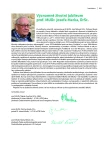Functional hypothalamic amenorrhea
Authors:
Luboslav Stárka; Michaela Dušková
Authors‘ workplace:
Endokrinologický ústav Praha, ředitelka doc. RNDr. Běla Bendlová, CSc.
Published in:
Vnitř Lék 2015; 61(10): 882-885
Category:
Reviews
Overview
Functional hypothalamic amenorrhea (FHA) besides pregnancy and syndrome of polycystic ovary is one of the most common causes of secondary amenorrhea. FHA results from the aberrations in pulsatile gonadotropin-releasing hormone (GnRH) secretion, which in turn causes impairment of the gonadotropins (follicle-stimulating hormone and luteinizing hormone). FHA is a form of the defence of organism in situations where life functions are more important than reproductive function. FHA is reversible; it can be normalized after ceasing the stress situation. There are three types of FHA: weight loss related, stress-related, and exercise-related amenorrhea. The final consequences are complex hormonal changes manifested by profound hypoestrogenism. Additionally, these patients present mild hypercortisolemia, low serum insulin levels, low insulin-like growth factor 1 (IGF-1) and low total triiodothyronine. Women’s health in this disorder is disturbed in several aspects including the skeletal system, cardiovascular system, and mental problems. Patients manifest a decrease in bone mass density, which is related to an increase in fracture risk. Therefore, osteopenia and osteoporosis are the main long-term complications of FHA. Cardiovascular complications include endothelial dysfunction and abnormal changes in the lipid profile. FHA patients present significantly higher depression and anxiety and also sexual problems compared to healthy subjects.
Key words:
exercise – food intake disturbances – hypogonadotropic hypoestrinismus – osteoporosis – secondary amenorrhea – stress – weight loss
Sources
1. Barrack MT, Ackerman KE, Gibbs JC. Update on the female athlete triad. Curr Rev Musculoskelet Med 2013; 6(2): 195–204.
2. Berga SL, Loucks TL. The diagnosis and treatment of stress-induced anovulation. Minerva Ginecol 2005; 57(1): 45–54.
3. Bomba M1, Corbetta F, Bonini L et al. Psychopathological traits of adolescents with functional hypothalamic amenorrhea: a comparison with anorexia nervosa. Eat Weight Disord 2014; 19(1): 41–48.
4. Caronia LM, Martin C, Welt CK et al. A genetic basis for functional hypothalamic amenorrhea. N Engl J Med 2011; 364(3): 215–225.
5. Dundon CM, Rellini AH, Tonani S et al. Mood disorders and sexual functioning in women with functional hypothalamic amenorrhea. Fertil Steril 2010; 94(6): 2239–2243.
6. Fourman LT, Fazeli PK. Neuroendocrine causes of amenorrhea – an update. J Clin Endocrinol Metab 2015; 100(3): 812–824.
7. Gordon MC. Functional hypothalamic amenorhea. N Engl J Med 2010; 363(4): 365–371.
8. Horn E, Gergen N, McGarry KA. The female athlete triad. R I Med J 2014; 97(11): 18–21.
9. Javed A, Kashyap R, Lteif AN. Hyperandrogenism in female athletes with functional hypothalamic amenorrhea: a distinct phenotype. Int J Womens Health 2015; 7: 103–111. Dostupné z DOI: <http://dx.doi.org/10.2147/IJWH.S73011>.
10. Lachowsky M, Winaver D. Psychogenic amenorrhea. Gynecol Obstet Fertil 2007; 35(1): 45–48.
11. Lambrinoudaki I, Papadimitriou D. Pathophysiology of bone loss in the female athlete. Ann N Y Acad Sci 2010; 1205: 45–50..
12. Laughlin GA, Dominguez CE, Yen SS. Nutritional and endocrine-metabolic aberrations in women with functional hypothalamic amenorrhea. J Clin Endocrinol Metab 1998; 83(1): 25–32.
13. Liu JH, Patel B. Central Causes of Amenorrhea. In: De Groot LJ, Beck-Peccoz P et al (eds). Endotext. South Dartmouth (MA): MDText.com, Inc: 2000-. Dostupné z WWW: <http://www.endotext.org/>.
14. Meczekalski B, Katulski K, Czyzyk A et al. Functional hypothalamic amenorrhea and its influence on women‘s health. J Endocrinol Invest 2014; 37(11): 1049–1056.
15. Misra M. Neuroendocrine mechanisms in athletes. Handb Clin Neurol 2014; 124: 373–386.
16. O‘Donnell E, Goodman JM, Harvey PJ. Clinical review: Cardiovascular consequences of ovarian disruption: a focus on functional hypothalamic amenorrhea in physically active women. J Clin Endocrinol Metab 2011; 96(12): 3638–3648.
17. Tschugguel W, Berga SL. Treatment of functional hypothalamic amenorrhea with hypnotherapy. Fertil Steril 2003; 80(4): 982–985.
18. Vescovi JD, Jamal SA, De Souza MJ. Strategies to reverse bone loss in women with functional hypothalamic amenorrhea: a systematic review of the literature. Osteoporos Int 2008; 19(4): 465–478.
19. Warren MP, Voussoughian F, Geer EB et al. Functional hypothalamic amenorrhea: hypoleptinemia and disordered eating. J Clin Endocrinol Metab 1999; 84(3): 873–877.
20. Warren MP, Brooks-Gunn J, Fox RP et al. Osteopenia in exercise-associated amenorrhea using ballet dancers as a model: a longitudinal study. J Clin Endocrinol Metab 2002; 87(7): 3162–3168
Labels
Diabetology Endocrinology Internal medicineArticle was published in
Internal Medicine

2015 Issue 10
Most read in this issue
- Functional hypothalamic amenorrhea
- Systemic glucocorticoids treatment: practical view
- Adrenal incidentaloma
- Adrenal insufficiency
